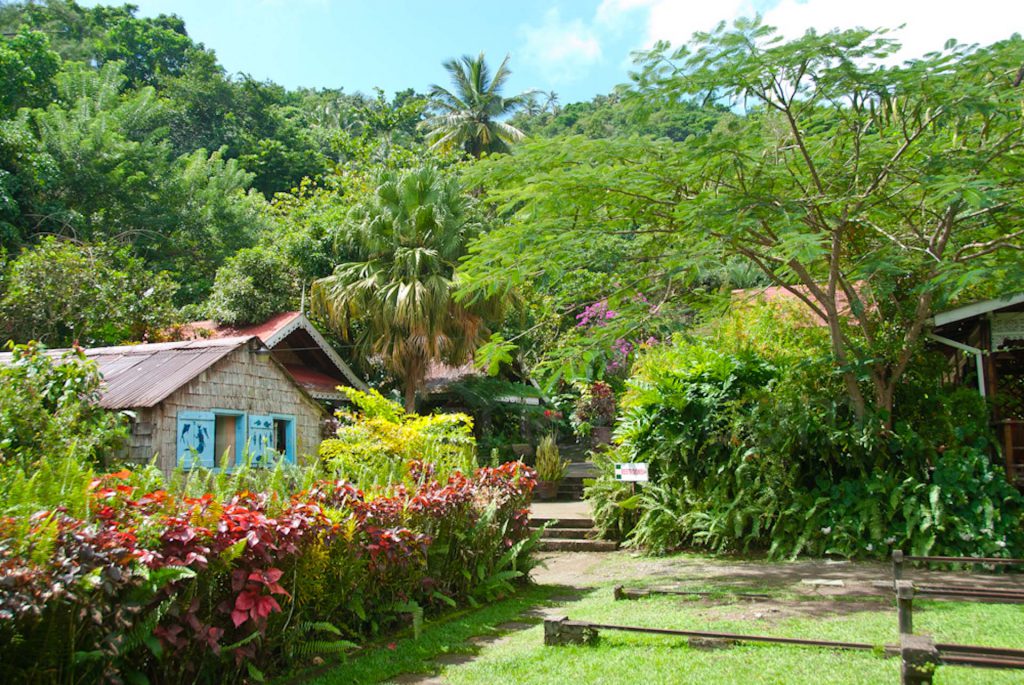Conservation of the cultural heritage of Saint Lucia
The history of Fond Doux Holiday Plantation dates back over 250 years and continues today through the intervention of its current owners, Lyton and Eroline Lamontagne. This couple of architecture and ecotourism enthusiasts are deeply involved in restoring 18th century colonial houses, thereby contributing to the conservation of the cultural heritage of Saint Lucia.
Villa Angelina, a symbol of architectural conservation
Among the restored houses, Villa Angelina is a great example of the architectural style of the French colonial period that was once prevalent around the island. Any visitor staying in this house will feel transported in time. The wood of the framework has remarkably stood the test of time and it has been possible to restore 90% of the original structure! It initially belonged to a local family living in Castries, then survived a fire in 1949 before being left derelict. After purchasing the villa in 2006, the owners of the Fond Doux Holiday Plantation dismantled and transported it to the domain, where it was restored following the original architecture. Villa Angelina is sophisticated with carved shutters framing the windows and doors as well as a long veranda extending to the lush garden of Fond Doux. It blends perfectly in a charming setting next to the 10 cottages.
Cottages with colonial charm and adapted to the climate of the Caribbean
The cottages are all built with wood and have been carefully laid out in the tropical forest of the plantation to avoid destroying the vegetation. A programme has indeed been implemented to plant about a thousand cocoa a fruit trees in order to compensate for the any degradation of nature.
The cottages are both sophisticated and functional; they were designed in a manner that optimises the use of sunlight and air, thus keeping the temperature fresh in the hottest months. The framework has been built to resist the most threatening natural hazards in Saint Lucia, including hurricanes.
The Jardin Cacao Restaurant, a taste of nature and the flavours of the Caribbean
The restaurant is built with local wood and is decorated with multicoloured flowers. It offers view of the outside and perfectly blends in the lush tropical garden of the plantation. Candles and lanterns, the colonial-style furniture and the decoration ring an old-fashioned and romantic touch to the place. It is a true haven of peace where you will feel in total harmony with nature.
Well-balanced organic meals
The same feeling extends to the taste buds as all the dishes are prepared with organic fruit, vegetable, herb and spices from the estate. Fish and meat are bought locally in order to allow the local community to benefit from tourism. The local chef uses seasonal fruit and vegetables from the garden and uses local herbs and spices to reveal the flavours of often revisited versions of traditional Creole specialities. Fresh local seafood and fish with green papaya gratin or organic meat marinated in coconut milk and plantain bananas are served. The menus are varied and feature healthy and balanced meals. Don’t forget to save some room for the inventive and delicious cocoa-based desserts.
Various cocktails and fruit juices are available at the bar as well as hot chocolate or traditional cocoa tea, a speciality of the plantation.
Entertainment is regularly offered by local calypso and reggae bands, transporting visitors in a warm and lively atmosphere.
Guided tour of the Fond Doux plantation
Guided tours are regularly offered to allow the discovery of the multiple species of fruit trees, plants and flowers on the estate as well as the traditional cultivation of cocoa. A local guide working for the establishment tells you the story of the estate, which is closely linked to cocoa cultivation.
The stages of cocoa production
What are the origins of chocolate, where and how is cocoa grown? You will find the answers at the Fond Doux plantation, where you will see cocoa pods on the trunks and branches of cocoa trees, which can reach 7m high. The ripening takes about 4 months. Our guide explains that each cocoa tree gives some 40 pods a year. Cocoa cultivation started 250 years ago in Fond Doux over almost 340 acres and the processing is still done the traditional way. Visitors can follow the different stages from harvesting, breaking the pods, fermentation and direct sun drying of the beans to the famous “cocoa dance”, a custom that is used to remove the shells and the beans this unique taste not found in industrially processed ones. Visitors are invited to watch the show live. Like for coffee, cocoa gives off its aroma only after roasting. The beans are roasted at 120°C to 140°C. Finally, the last stage is the grinding of the beans into a liquid paste.
Cocoa tea, a traditional brew in the Caribbean
It is only after the abolition of slavery in 1833 that the inhabitants of Saint Lucia started drinking cocoa tea, a spicy traditional brew with cinnamon and nutmeg. Soufrière has a number of small sugarcane, coffee and cocoa plantations. Tea leaves were hard to find at the time but cocoa was accessible and cheap. This beverage is still drunk every day by the locals.
Mamma La Terre Spa
Mamma La Terre was inaugurated in July 2008. It offers care and treatment with local natural and organic products and using traditional knowledge of plants and berries. The treatment menu, for example, features spa treatments that are based on plants, fruit and local minerals coming directly from the garden and varies with the seasons.



